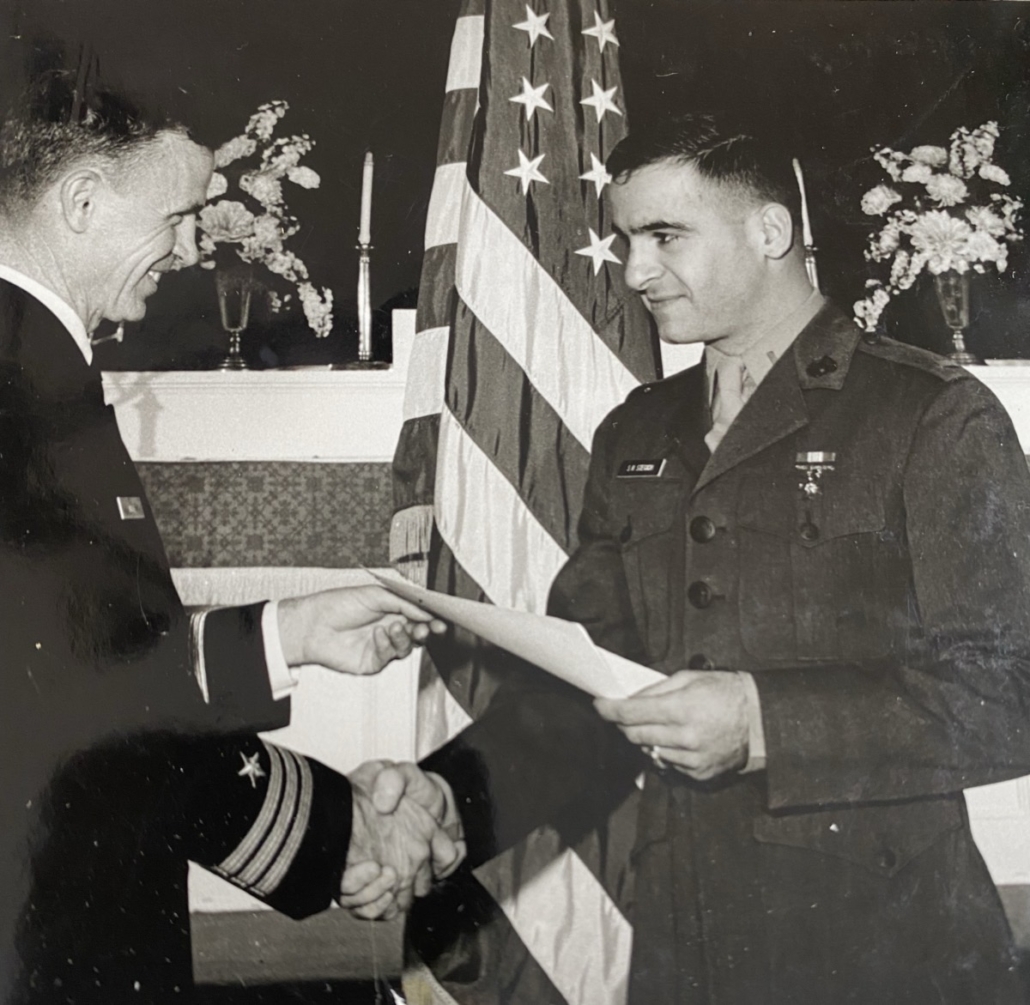57 Years Later, Reflections on the Tet Offensive
By Professor Errin T. Stegich-Moloney
In the cold morning hours of January 20th 1968 the 3rd Battalion, 26th Marines were making their way down the fog-covered terrain of Hill 881 South when they came under heavy NVA fire.[1] India Company took heavy casualties during this engagement necessitating a helo evacuation. Within a few hours a “Marine [Sea Knight] CH-46 helicopter—Frosty Gold of Marine Medium Helicopter Squadron 262 (HMM-262)—whomped in from the east, banked and turned toward a makeshift [landing zone] alongside the casualty collection point,” (Jones, 15). The pilot, Captain Bob Ropelewski, and co-pilot, Captain Steve Stegich of the Sea Knight attempted to clear the area and collect the wounded while taking heavy fire from NVA machine guns; their bullets ripped through the fuselage and severed the fuel line. Instantly the CH-46 burst into flames. Under enemy fire, the crew bailed just before the CH-46 crashed into the jagged hillside. Within minutes of the crash, the injured crew were recovered by another Marine platoon and brought down the hill for evacuation; escaping the NVA assault, injured and wounded, but alive.
Later that day, the NVA launched a full-scale assault on the American Marine base at Khe Sanh, near the northern border of South Vietnam. The attack at Khe Sanh hinted, and seemed to confirm, that the North Vietnamese were planning something big. The fight on Hill 881 South in Khe Sanh was a prelude to the Tet Offensive.
On the night of January 30th 1968, the first day of the Vietnamese New Year (Tet), communist forces launched an enormous, concerted attack on American strongholds throughout South Vietnam. Twelve towns in the northern part of South Vietnam were attacked in a coordinated effort that showed the strength and determination of the Viet Cong. According to estimates, the “insurgents hit 5 out of 6 [major] cities, 36 out of 44 provincial capitals and 64 out of 245 district capitals,” (Overy, 260). Significant fighting took place in the streets of cities like Hue, Da Nang, Quang Tri, and Saigon. By the end of March, American forces had dislodged the Viet Cong from their positions in the South, resulting in an eventual American victory, but a psychological defeat for the war in Vietnam.
The Tet Offensive inflicted enormous casualties, an estimated 32,000, on the communist forces and permanently depleted the ranks of the Viet Cong, forcing the North Vietnamese to take on a much larger share and burden of the fighting in the South. But what made the Tet Offensive so shocking to the American people, who saw vivid reports of it on television, was the sight of communist forces in the heart of Saigon, setting off bombs, shooting down South Vietnamese officials and troops, and holding down fortified areas. The Tet Offensive also suggested to the American public something of the brutality of the fighting in Vietnam. President Johnson’s administration was never able to politically recover from the psychological defeat inflicted by the Tet Offensive on the American psyche.

Captain Stephen R. Stegich, III, USMC (Ret)
On March 14th 1969, just three days before his 26th birthday, while resupplying the Marine Combat base near Hill 861, my uncle and his crew were shot down again. This time he was seriously wounded. Their Sea Knight “took hits in the cockpit, cabin, and engines, resulting in loss of both engines. [Captain Greg Rengel] flew aircraft to the best of his ability to a controlled crash which prevented the loss of any lives…Both pilots had to be evacuated to the United States due to their injuries,” (Allen, n.p.). My uncle was shipped home to recover from his injuries; he retired from the U.S. Marines Corps that month. With a military scholarship, he studied law at Notre Dame University earning his Juris Doctor. He went on to become a very successful corporate attorney in New York City; his last case was argued before the United States Supreme Court.

Captain Stephen R. Stegich, III, USMC (Ret)
My uncle passed away in 2021 and would never talk about his wartime service in Vietnam. What I have been able to find out about what he did comes from second-hand sources, books like Gregg Jones’s Last Stand at Khe Sanh (2014) and Marion Stukey’s Bonnie Sue: A Marine Corps Helicopter Squadron in Vietnam (1997).[2] By the end of his service in 1969, my uncle was awarded the Air Medal with 5 stars, a National Defense Medal, a Presidential Unit Citation for “extraordinary heroism in action against the enemy,” and the Purple Heart. I still have his flight jacket, and I bring it to class with me every time I teach the Vietnam War.
This March marked the 57th anniversary of Khe Sanh and the Tet Offensive, and I covered the Vietnam War in my contemporary history class this semester. For me, teaching the Vietnam War brings a sense of personal connection to those who fought and died in the jungles of Vietnam…those individuals like my uncle who faced near-certain death at time when the war in Vietnam escalated to a critical point. I think author Tim O’Brien summed up the experiences of the Vietnam War best in his seminal work The Things They Carried, “They carried all they could bear, and then some, including a silent awe for the terrible power of the things they carried.”
References and Suggested Further Reading
Allen, LtCol Neil “Sam Small.” “Narrative of HMM-262 Command Chronology.
HMM-262 Combat Helicopter Association. Date of Access: 7 March 2025.
https://www.hmm-262combatvets.org/chronology.htm
Jones, Gregg. Last Stand at Khe Sanh: The U.S. Marines’ Finest Hour in Vietnam.
New York: De Capo Press (2014) 15.
O’Brien, Tim. The Things They Carried. Boston/New York: Houghton Mifflin Harcourt, 1990.
Overy, Richard. A History of War in 100 Battles. New York: Harper Collins Publishers (2014), 260.
Stukey, Marion F. Bonnie-Sue: A Marine Corps Helicopter Squadron in Vietnam. Plum Branch, South Carolina: Heritage Press International Books, 1997.
[1] North Vietnamese Army.
[2] See Stukey, Page 452.




